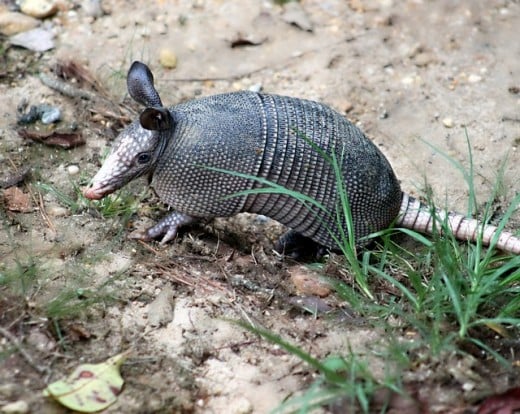Nine-Banded Armadillo Population is Expanding to North Carolina

Armadillo Characteristics
The nine-banded armadillo, native to Central and South America, has been traveling north into the US since1849, and now has found its way to North Carolina.
About the size of an opossum, the armadillo, also like the opossum, is often seen as roadkill along southeastern roadways. Alive or dead this strange looking mammal is easy to identify due to its unique armor-like skin made of over-lapping plates which cover it from head to toe. The nine bands allow it to roll up into a tight ball when threatened by a predator. Its pointed nose profile and ears make it resemble Piglet of Winnie the Pooh.
They move slowly as they forage for bugs, grubs and worms. They have poor eyesight but a keen sense of smell. In hot weather they feed mainly from dusk to dawn. In winter they can be found out and about during the day. These characteristics and their slow pace and erratic movements probably account for them becoming roadkill.
Armadillo Reproduction
The armadillo is related to anteaters and sloths. The females dig a burrow where their young are born usually in March or April. The litter always consists of quadruplets - all of the same sex. The nursing babies stay in the nest for about three months. They are weaned and begin foraging with their mother in six more months, then they strike off on their own.
Benefits
Other that digging holes in lawns they are pretty harmless. And if you have fire ants you would be happy to have these little critters around as they love ants and will gobble them right up.
Do Armadillos Carry Leprosy?
Many people become alarmed at the thought of armadillos in their areas because they are reputed to carry leprosy. According to a research paper published on the Centers for Disease Control website “Nine-banded armadillos (Dasypus novemcinctus) are naturally infected with Mycobacterium leprae and have been implicated in zoonotic transmission of leprosy. Early studies found this disease mainly in Texas and Louisiana, but armadillos in the southeastern United States appeared to be free of infection.”
The risk is very low to ever encounter an infected armadillo. But it is possible, though not probable, to catch the disease by eating an infected armadillo
Eating Armadillo Meat
During the depression years armadillos were hunted and eaten extensivity in Texas and were known as “poor man’s pork” as it is claimed it tastes like pork. A quick Google search will bring up recipes and the meat is declared to be tasty. Personally, I’d have to be starving to eat one. I think the best advice is given by the CDC: avoid handling and eating the creatures all together.
But, if you're game here's a recipe to try:
Armadillo ‘N Rice
1 armadillo, dressed and cleaned
4 large onions
1 stalk celery
2 cans chopped mushrooms
2 cups rice, uncooked
Salt and pepper to taste
10 cups armadillo broth
Boil armadillo until tender; reserve broth. Remove meat from bones. Cut onions and celery and cook in butter until tender. Add mushrooms and meat and simmer for 5 minutes. Put in a large baking pan or dutch oven and add 10 cups of hot broth; add rice, salt and pepper; stir. Place in 375 degrees F. oven and cook until tender. Serves 12.
Report Sightings
The N.C. Wildlife Resources Commission is asking the public to report sightings of this peculiar looking mammal to the agency so they can monitor the range expansion of armadillos into North Carolina. Twenty-seven counties from the coast to the mountain have had reports of armadillos. It seems as though most of those sightings are dead armadillos seen on the roadside. The NC wildlife commission sites warmer winter temperatures as the reason for expansion into the state. To report seeing an armadillo email armadillo@ncwildlife.org and give the location and date, plus a photo if possible.








